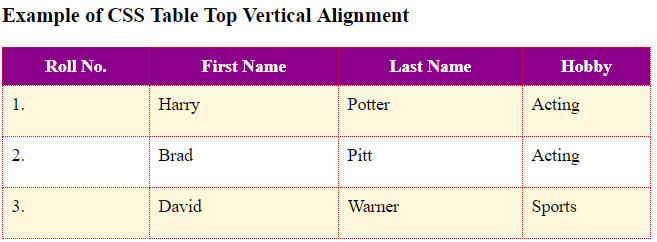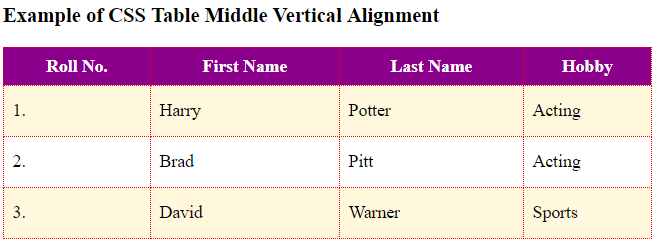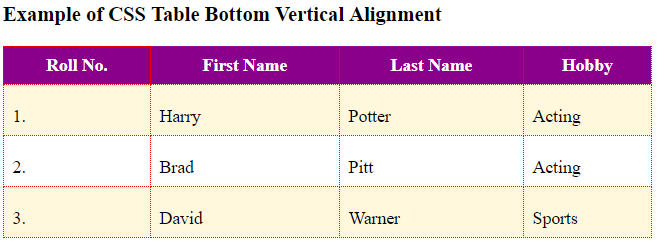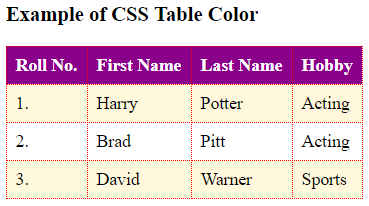Definition:
CSS striped property is used to change the row background color into striped format with even and odd rows. You can use a different color background striped. To select the color, visit “Standard Color Names“.
Syntax:
tr:nth-child(even){
background-color: cornsilk;
}
tr:nth-child(odd){
background-color: #f0f8ff;
}Source Code:
<!DOCTYPE html>
<html>
<head>
<style>
table {
border-collapse: collapse;
}
table, th, td {
border: 1px dotted red;
}
th, td {
text-align: left;
padding: 8px;
}
th {
background-color: darkmagenta;
color: white;
}
tr:nth-child(even){
background-color: cornsilk;
}
</style>
</head>
<body>
<h3>Example of CSS Striped Table</h3>
<table>
<tr>
<th>Roll No.</th>
<th>First Name</th>
<th>Last Name</th>
<th>Hobby</th>
</tr>
<tr>
<td>1.</td>
<td>Harry</td>
<td>Potter</td>
<td>Acting</td>
</tr>
<tr>
<td>2.</td>
<td>Brad</td>
<td>Pitt</td>
<td>Acting</td>
</tr>
<tr>
<td>3.</td>
<td>David</td>
<td>Warner</td>
<td>Sports</td>
</tr>
</table>
</body>
</html>
Output:
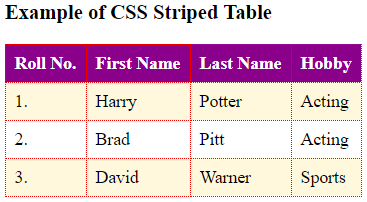
CSS Striped Odd Rows: Source Code
<!DOCTYPE html>
<html>
<head>
<style>
table {
border-collapse: collapse;
}
table, th, td {
border: 1px dotted red;
}
th, td {
text-align: left;
padding: 8px;
}
th {
background-color: darkmagenta;
color: white;
}
tr:nth-child(odd){
background-color: cornsilk;
}
</style>
</head>
<body>
<h3>Example of CSS Striped Table on Odd Rows</h3>
<table>
<tr>
<th>Roll No.</th>
<th>First Name</th>
<th>Last Name</th>
<th>Hobby</th>
</tr>
<tr>
<td>1.</td>
<td>Harry</td>
<td>Potter</td>
<td>Acting</td>
</tr>
<tr>
<td>2.</td>
<td>Brad</td>
<td>Pitt</td>
<td>Acting</td>
</tr>
<tr>
<td>3.</td>
<td>David</td>
<td>Warner</td>
<td>Sports</td>
</tr>
</table>
</body>
</html>
Output:
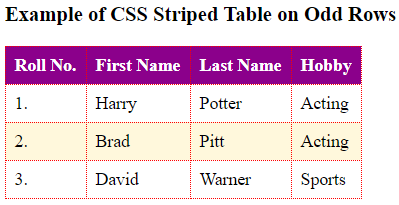
CSS Striped Used on Even and Odd Rows Together
<!DOCTYPE html>
<html>
<head>
<style>
table {
border-collapse: collapse;
}
table, th, td {
border: 1px dotted red;
}
th, td {
text-align: left;
padding: 8px;
}
th {
background-color: darkmagenta;
color: white;
}
tr:nth-child(even){
background-color: cornsilk;
}
tr:nth-child(odd){
background-color: #f0f8ff;
}
</style>
</head>
<body>
<h3>Example of CSS Striped Even and Odd Rows</h3>
<table>
<tr>
<th>S.No.</th>
<th>First Name</th>
<th>Last Name</th>
<th>Hobby</th>
</tr>
<tr>
<td>1.</td>
<td>Harry</td>
<td>Potter</td>
<td>Acting</td>
</tr>
<tr>
<td>2.</td>
<td>Brad</td>
<td>Pitt</td>
<td>Acting</td>
</tr>
<tr>
<td>3.</td>
<td>David</td>
<td>Warner</td>
<td>Sports</td>
</tr>
<tr>
<td>4.</td>
<td>Salman</td>
<td>Khan</td>
<td>Acting</td>
</tr>
<tr>
<td>5.</td>
<td>Sachin</td>
<td>Tendugar</td>
<td>Sports</td>
</tr>
</table>
</body>
</html>
Output:
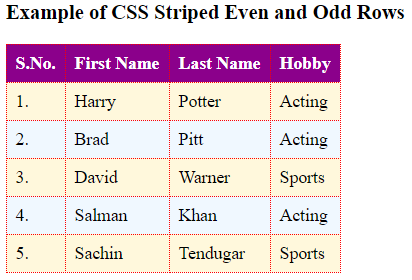
You may be interested in the following topics:









